Amid community support, DMS robotics continuing to grow
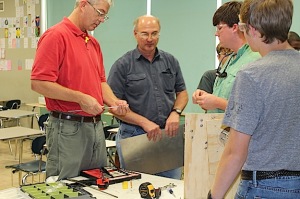
Robotics at Demopolis Middle School has uniquely captured the imagination and interest of the city since it started last fall.
“I’m excited to see the community investing in their young people to where it can actually make a difference in their lives,” said Ashley Brock, the DMS science teacher and robotics team sponsor.
DMS principal Blaine Hathcock said in his 21 years in education it’s the first time people have called to give money to an academic program.
“We’ve had four or five different businesses call us and ask, ‘How can we be involved’,” he said.
One business has given $500 worth of tools, and another donated lumber.
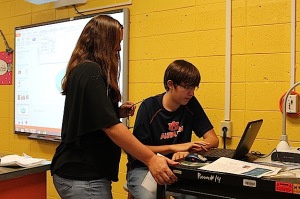
“They’re investing in the future of these kids and possibly in the future of Demopolis,” Brock said, by training the city’s future work force. “To me that has been the biggest blessing, the support of the community.”
Brock, who admits she hates soliciting help, said, “Personally I’ve learned that people will help you if you ask.” For instance, the Demopolis High Ag Shop is building a practice field to test the robot before competition.
More than financial support, however, are the volunteers who mentor the students. Returning this year are Jimmie Lee and Chris Stewart from Georgia Pacific and Thomas Langham of Alabama Power. Joining them are Garrett Moore of GP, Jimmy Gillespie of Alabama Power and Elizabeth Smith a Demopolis resident who works for Rhea+Kaiser Marketing Company headquartered in Naperville, Ill.
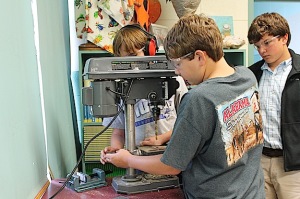
All are volunteers, said Brock. None of them have children in program, and they spend hours working with the team at the school “out of the goodness of their hearts and just wanting to help their community,” she said. “They really embrace the spirit of the program for letting the kids learn and letting the kids explore and actually figure out the engineering process.”
Lee volunteered initially out of curiosity. “As I very quickly got involved with the kids it was a lot of fun.”
He and Steward, both electrical engineers, have “zero experience” working with robotics, he admitted. “We’re eighth graders.”
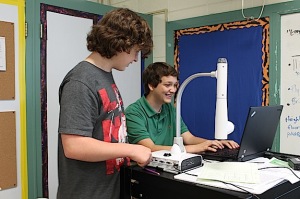
Stewart joined because “both my boys were finished with sports, and I needed to find something to do with my time, and I wanted to give back.”
He also supports what the Boosting Engineering, Science and Technology (BEST) program stands for. Besides, he added, “It really is a lot of fun.”
He said the volunteers are novices at building. “We’re learning, but we’re trying to teach them the (engineering) process.”
A lot of the students have never used hand tools. Those in ninth grade who were on the team last year show a remarkable improvement in skills, Stewart said.
The team this year is about twice the size of the first one, said Brock. Some 40 students are taking part, including 12 from last year’s team who now are at DHS.
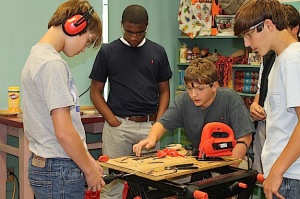
“We do a lot in class, so I miss (the DHS students) during the day, but in the afternoon they provide the experience,” she said.
The advantage to having a bigger team is less overlap of responsibilities, said Brock. The work can be spread out more.
“There was a huge learning curve last year,” she continued. This year “we’re not wasting time trying things that we know won’t work because we have experience with it now.”
Taking the judges’ comments from last year in consideration, the 2014 team is expanding and refining the presentation this year. “We’re trying to brand ourselves and trying to model it like a company, a business,” explained Brock.
Students are putting together a marketing plan and presentation, building a web site, organizing an informational booth and handling all the other aspects of a business.
The challenge for BEST teams this year is to build a robot that can transport windmill parts and assemble a windmill. The focus of the competition is on wind energy.
On Thursday the team will travel to Shelton State to test out its robot. It then has until the official competition Nov. 1 to tweak the design and eliminate any glitches.
Also due on Thursday is the engineering notebook that describes all the steps taken by the team in the design process. Parker Hallmark is putting the book together.
“When we win, everybody will be jumping up and down, and I’ll be sitting to one side twiddling my thumbs, waiting for the scores of the engineering notebook,” he said.
And winning is the team’s goal. At its first competition in 2013 the DMS team came in second over dozens of other teams, many with years of experience. It was an exceptional feat since the middle school group faced off against high school teams.
After Shelton State the team has one month to improve the presentation before the regional BEST competition at Auburn Dec. 6.
“Like a football team from week to week, we’ll watch themselves on film,” said Brock. “Just like any other sport from week to week we will sit down and come up with another game plan – what can we work on, what can we improve on.”
The robotics course is an elective for eighth graders in the fall. The spring semester will introduce robotics to seventh graders.
Since the interest in robotics is growing so rapidly, Brock is trying to figure out how to manage the number of students who want to take part. Right now the whole class of robotics is considered part of the team. It might turn into the class just be an introduction, and the team would be whoever would meet after school.
“My goal is that those who stick with it, by the time they are seniors, I’ll have scholarships for them,” she said.
Brock is overwhelmed by the support from the people of Demopolis. “It’s very humbling because it wasn’t me that started the program.” The idea came from counselor Traci Pearson and Hathcock who asked her to lead it.
“It’s not me. It’s the support of the community,” she said. “That’s why I love it. I’m learning so much myself. I feel like I’m a team member more than a sponsor.”
